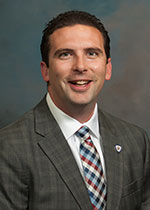
In this series, guest columnists choose to reflect on one of three prompts provided by ELGL Co-Founder Kent Wyatt. This week, Jon Stehle, Councilmember at the City of Fairfax, Virginia and Director at Tyler Technology, writes about balancing a day job with the responsibilities of a councilmember.
In Virginia, being an elected official is a part time job. Though, more often than not, the part time intersects with the fulltime job. This combination requires lots of switching between roles. One minute I could be on the phone with a client talking about the next release of our product, the next minute our City Manager could be calling with an update on the latest COVID-19 numbers or to inform the Council that our Chief of Police has just finished posting our analysis of the 8cantwait police reform agenda to the public.
Here are three takeaways from my role leading teams in the data analytics field that I find cross both jobs:
1. Translating – What is the problem we will solve with our client?
Developers think differently than Clients. This is a good thing. However, it means that bridging the gap between what our clients “think” they want and what the developers can (or think they can) do with the technology requires a Rosetta Stone like approach. Both sides need a shared understanding of the problem we are trying to solve. Is the problem that the systems are not communicating with one another (technology issue) or that the Director of Department X is not communicating with the Chief Financial Officer (organizational change issue)? Even the most beautiful of code bases cannot fix the second issue. The same is true for me as a councilmember. If we are holding a public hearing and the problem being addressed is not clearly defined so that citizens, city staff, city council, and contractors all have a shared understanding of what we are addressing, the conversation will not move forward. My role in both is to listen to all perspectives and help translate to ensure we have a shared definition of the problem.
2. Tracking – What metrics are we using?
Once we have (or at least think we have) the problem defined, our team needs to create the solution to solve the problem. I learned long ago that what gets measured, gets done. However, the what to measure question is an area where my role in data analytics has helped me think differently as a Councilmember. The client needs one set of data while the company needs a different set to ensure the same product is on track. My role here is to help facilitate both sets of data and make sure they are translating to the same goal. Same is true as a councilmember. Our citizens, city staff, city council, and contractors value different sets of data when gauging success. My job as a councilmember is to ensure that we are using the correct metrics, gathering the right data, and sharing it in an effective manner for all engaged parties. But most importantly, my job is to listen to the different perspectives to make sure we are all still addressing the same problem.
3. Closing – When will the money be in the bank?
A rule of business development: it’s not done until it’s done. From my day job perspective, this means that until the contract is signed AND the governing body has approved it, the team is not in position to tell the CFO when the money will be in the bank. For a company, this is critical to survival. With the uncertainty created by COVID-19, we have to find the balance of planning ahead, anticipating a budget shortfall while trying to do the most good with the money currently in the bank. Asking directly when the money will be in the bank gives me as a Councilmember the chance to focus on the reality of the moment, not a hope or a projection for the future state.
These three takeaways – translating, tracking and closing – provide me a framework for switching back and forth in my day-to-day. They also provide lenses to address larger issues we are facing. I recently put up a blog post for Chesapeake Bay Awareness Week where I noted that we need to listen differently and learn differently if we are going to sharpen our focus on equity. If we are going to address issues of equity, we must acknowledge the reality of COVID-19 – that not all people are impacted equally. I believe we have the chance to address equity as we begin to chart our phased approach to reopening, including return to school plans, telework arrangements, living wages and many more that have become top of mind to localities with the physical distancing required during this pandemic. It will be at the local level where we make it happen. If we take the time to find a shared view of a specific problem, determine the right internal and external metrics to track success and tie that back to known funding, we can communicate successes to our communities. Now is the time to take this moment of uncertainty and use it to transform the way local governments and their citizens solve problems together for future generations. I look forward to sharing with you more of our story in the City of Fairfax as we continue this journey.
Supplemental Reading
Podcast: The Candidates with Jon Stehle and Josh Dukelow
The Path Forward: Five Critical Needs for Today’s Budgeteers
